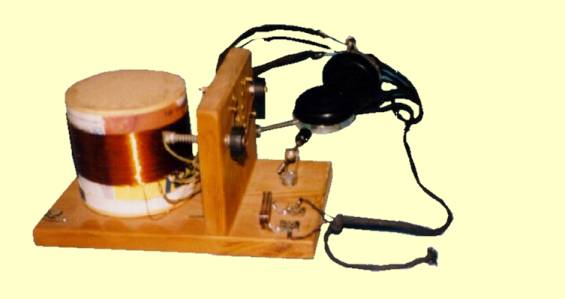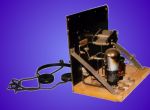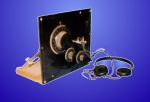
My First Radios
As I mentioned before I developed an active interest in building a radio as a young boy. Times were tough so most of my experiments dealt with odds and ends scrounged from whatever source I could find. I attempted to build some crystal radio sets but had very little luck. I don't remember ever hearing a signal from any of the sets, probably due to several factors.
The first problem was there weren't any close radio stations making the signals too weak and of course there was my inexperience. I had tried several different types; I even used coal as a detector. I think it should have been a hard coal but we had the soft types. I had even tried to use a carbon rod from a dry cell but no success. Then there was the lack of equipment that suited the purpose; in particular I did not have a good sensitive set of earphones.

Maybe it was the memory of all those experiments that prompted me to build this reproduction of the National Broadcasting System Radio, originally published in the newspapers some time in the 1920ís. I built this from a magazine article published in 1996. I had just about all the parts from my childhood radio building days. It uses the galena crystal that was commonly used in those early years. The lever with the wire spring was known as a cat whisker. It had to be adjusted to a sensitive spot on the crystal. A bump or jar could dislodge it and you would have to adjust it again.
This type of radio uses no external power. It rectifies the radio frequency energy that is picked up from a large outdoor wire antenna. A good ground was also a necessity. The headphones had to be very sensitive to a very low voltage. In this day we have many AM radio stations that are not too far distant so it will perform a lot better than in the early days when stations were low powered and far away.
The selectivity of this circuit is very good considering that there is no variable tuning condenser. I was able to tune in 5 different stations on a recent winter evening. So I guess all those experiments paid off, I just had to have patience and keep trying.
Now before you think that all my childhood experiments ended in failure I'll tell you about one of my rigs that did work and I have restored it as well. This was constructed when I was about 12 years old and in junior high school.


It is a regenerative circuit type receiver. A rotatable feedback coil causes the regeneration inside the antenna coil. Rotating the coil very carefully controls the amount of feed back to the edge of oscillation. This produces a great deal of gain in sensitivity. This requires headphones to listen to the stations and also a good outside antenna wire. Preferably a good earth ground as well.
The power was supplied from two battery sources, one 5-6 volt for the filament and the other about 45 volts for the plate supply. All the components along with the tube (a 301A) were scavenged from old junk radios. The original batteries were salvaged from old telephones that the town of Alta, IA discarded when the telephone system was changed from operator service to the rotary dial system.
I had wound the coil for some short wave frequencies. I did not know what frequency it would tune to, as there were no coil winding instructions from the book I read the schematic from. The first station I can remember hearing on this radio was London England. I let out such a war whoop when I heard the bong of Big Bend that my mother rushed to the basement thinking I had been hurt.
Once the first sound was heard from this contraption I had to try and improve it. I made an audio amplifier so I did not have to wear headphones to hear it. I mounted a speaker up between the floor joists, which was under the kitchen. When this speaker would produce loud noises my mother said it tickled her feet. She seemed to put up with it fairly well, I suppose like all mothers she was happy she knew where her son was and what he was doing.
This radio brought me much enjoyment and experience but was torn apart many years ago and the parts laid back or used for other projects. I ran across the front panel in 1996 so I reconstructed it from memory. It works very well again on the broadcast band. I tried an AC power supply but it does not work as well as when batteries are used for power. (If you entered this page from the Ham Page you can click here to return there)
Click here to return to my Restoration Page or here to return to my Home Page
If you want more information please send me e-mail.